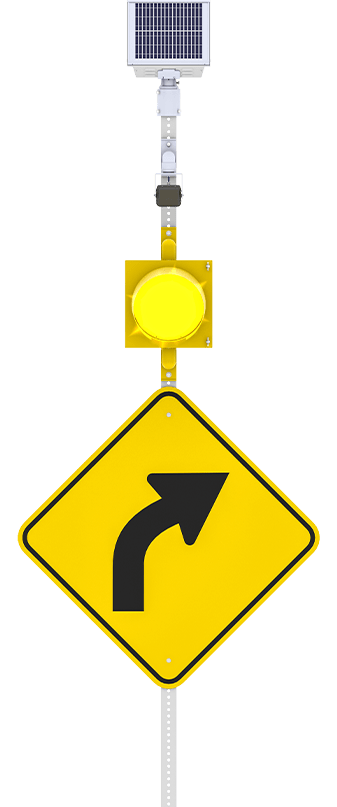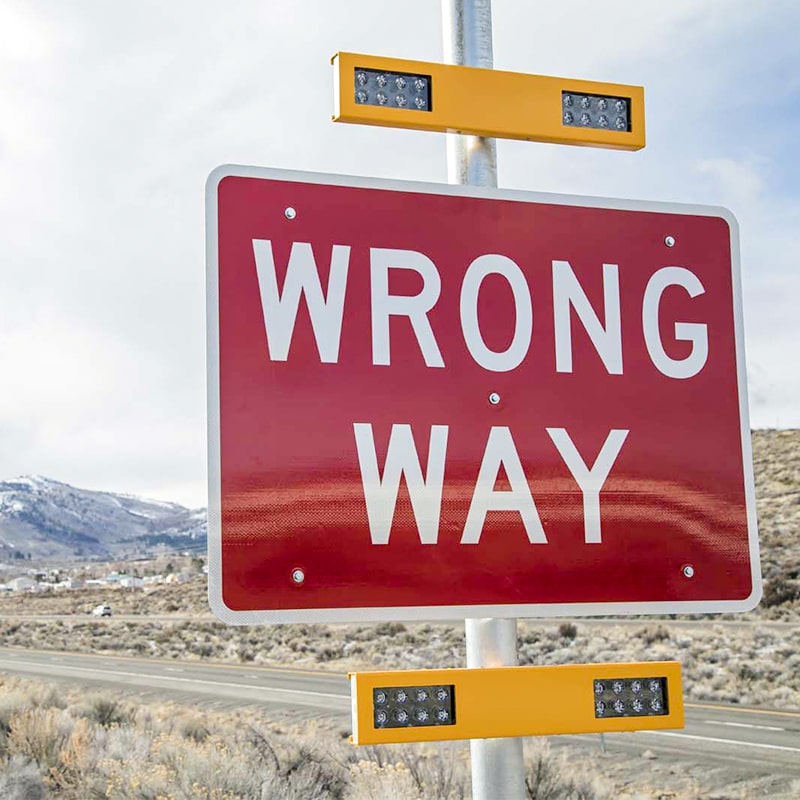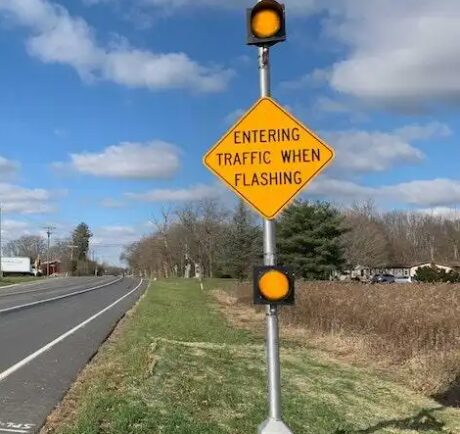Vehicle Detection Systems
Disrupt driver inattention and increase compliance and safety with radar-triggered beacons and LED-enhanced signs.

Vehicle-Activated Lighting: Enhanced Driver Awareness with Radar Detection
Research has shown that even the best and brightest lights can become less effective over time as drivers, particularly those who travel a route regularly, become desensitized to them. One of the best ways to counter this problem is to trigger lights only when a vehicle is detected.
Carmanah offers this vehicle detection capability on many of our products, leveraging top-tier radar technology to activate high-intensity flashing LED lights. These systems effectively attract the attention of oncoming drivers and communicate an appropriate course of action the driver should take (reducing their speed ahead of a curve for example).
Unlike other more invasive detection technologies, Carmanah’s systems require no trenching or ducting, drastically reducing installation costs and disruption. Systems can be mounted on standard poles, with a choice of LED-enhanced signs, circular beacons, or both, The radar unit’s parameters can be adjusted for detection speed, sensitivity, vehicle direction, and more. And as you would expect, each of our solar products is backed by Carmanah’s trademark Solar Power Report, ensuring system efficiency and sustainability for the long-term.
Vehicle Detection Technology Features
- Disrupts “driver autopilot” – The onset of something new—especially flashing lights—is extremely effective at drawing drivers’ eyes and attention.
- Accurate and reliable detection – System uses high-quality/low-power radar to monitor roadways 24 hours a day for vehicles without interfering with other traffic detection systems.
- Highly configurable – Systems can be tailored to a variety of applications and requirements with an array of sign and beacon options as well as adjustable radar zones and settings.
- Precise traffic data – Radar collects and stores detailed traffic data including time, date, and travel speed.
- AC and solar power options – Installation is possible virtually anywhere with off-grid power and a Solar Power Report prepared for every location.
- FHWA/MUTCD compliant – Compliance reduces your risk, meets requirements for federal funding, and provides the benefit of driver familiarity with sign faces, colors, sizes, and shapes.


Advantages of radar for vehicle detection
Long-range detection
The third party tested radar unit Carmanah uses is ideal for long-range outdoor applications up to 1,000 feet.
Accurate in all weather
Unlike other types of sensors, radar sensors are not affected by conditions like wind, rain, fog, humidity, and high and low temperatures.
Easy to install
No trenching or pavement cutting is required for installation, saving departments time and money, and limiting disruption to road users.
Detailed data
System collects and stores the number of vehicles plus accurate speed data to be used with user-configurable radar zones.
Long-range detection
The third party tested radar unit Carmanah uses is ideal for long-range outdoor applications up to 1,000 feet.
Accurate in all weather
Unlike other types of sensors, radar sensors are not affected by conditions like wind, rain, fog, humidity, and high and low temperatures.
Easy to install
No trenching or pavement cutting is required for installation, saving departments time and money, and limiting disruption to road users.
How is vehicle detection technology used in safety countermeasures?

Wrong-way driver systems
Typically installed on freeway exit ramps, radar-triggered flashing signs and light bars accurately detect wrong-way vehicles, warn drivers of their mistake, and encourage self-correction—before a crash occurs.

Intersection conflict warning systems
Intersection conflict warning systems dramatically reduce crashes at hazardous unsignalized crossings by providing real-time advance warnings to drivers about the presence of oncoming cross traffic.

Curve warning systems
Commonly used on rural roads and highway ramps, curve warning systems use flashing beacons and signs to increase driver awareness, bring attention to speed, and ultimately reduce road departures and crashes.

Hazard warning systems
Radar-triggered beacons and signs can be used to give drivers advance notice of potentially hazardous conditions on or near a road, such as crosswalks, hidden driveways, and railway, bicycle, and wildlife crossings.

Wrong-way driver systems
Typically installed on freeway exit ramps, radar-triggered flashing signs and light bars accurately detect wrong-way vehicles, warn drivers of their mistake, and encourage self-correction—before a crash occurs.

Intersection conflict warning systems
Intersection conflict warning systems dramatically reduce crashes at hazardous unsignalized crossings by providing real-time advance warnings to drivers about the presence of oncoming cross traffic.

Curve warning systems
Commonly used on rural roads and highway ramps, curve warning systems use flashing beacons and signs to increase driver awareness, bring attention to speed, and ultimately reduce road departures and crashes.

“The flashing onset of something new is the most effective thing you can do to draw someone’s eyes and attention… People’s brains are hardwired to pay attention to things that abruptly appear, and virtually everything we tested with a red flashing light worked well.”
– Walter Boot, Florida State University psychology professor & author of two FDOT wrong-way driving reports
Key Research Findings
Proven Safety Benefits of LED-Enhanced Signs and Beacons
A number of research projects have examined the safety impacts of LED-enhanced signs and beacons in both continuous and vehicle-actuated installations. The results of some of these studies are summarized below.
- The addition of a flashing LED (constant flash) border on minor-leg stop signs at 15 intersections in Minnesota produced a 41.5% reduction in angle crashes (Davis et al. 2014)
- The installation of standard stop sign mounted beacons (constant flash) at five sites in North and South Carolina produced a 58.2% reduction in angle crashes (Srinivasan et al. 2008)
- One study in North Carolina considered the safety impacts of installing vehicle entering when flashing signs with flashing beacons at or near 74 rural and urban intersections. The systems installed were a combination of those that alerted only the major approach vehicle drivers and others that alerted both major and minor approach drivers. The systems that only warned the major approach drivers (23 sites) reduced total crashes by 32 percent and those that warned both major and minor approach drivers (7 sites) reduced total crashes 25 percent (Simpson and Troy 2013).
- A study of a system that used a flashing LED border around a vehicle approaching when flashing sign found a 4.5 mph average decrease in vehicle speed (on all intersection approaches) when the LED flash was activated (Kwon and Weidemann 2010).
Combatting highway hypnosis
Most people who have driven for extended periods of time have experienced some version of “highway hypnosis,” a mental state that tends to occur on monotonous roads when your brain is occupied by things other than driving. Contrary to the name, it doesn’t only happen on highways—studies have found that drivers travelling familiar routes of all kinds are particularly prone to “increased mind-wandering.”
Though the worst outcome most of us will experience is a missed exit or jolt from a rumble strip, driver inattention is a major factor in serious and fatal traffic crashes, contributing to over 45 percent of all crashes and near-crashes that occur in an urban environment. Fortunately, vehicle detection systems like Carmanah’s can help bring drivers’ attention back to the road, decreasing collisions and increasing safety for all road users.


Using vehicle detection to increase stop sign compliance
In a residential part of Sammamish, WA, a busy 3-way stop was generating complaints from the community as some drivers were ignoring the stop signs. Since the intersection was in a residential area where traffic is light during the nights and weekends, the city didn’t want the sign to flash 24/7, and they wanted to avoid the cost and time associated with connecting the system to AC power. Carmanah and its Washington distributor Western Systems were able to deliver a system that met all of their requirements, increasing compliance, safety, and efficiency at the same time.
As this graphic illustrates, even if the accident is not prevented, the risk of death or serious injury is dramatically reduced with a reduction in vehicle speed
Get in touch
Have questions or need assistance? Connect with sales for product inquiries and quotes, support for technical issues, or visit the product support center for self-service resources.